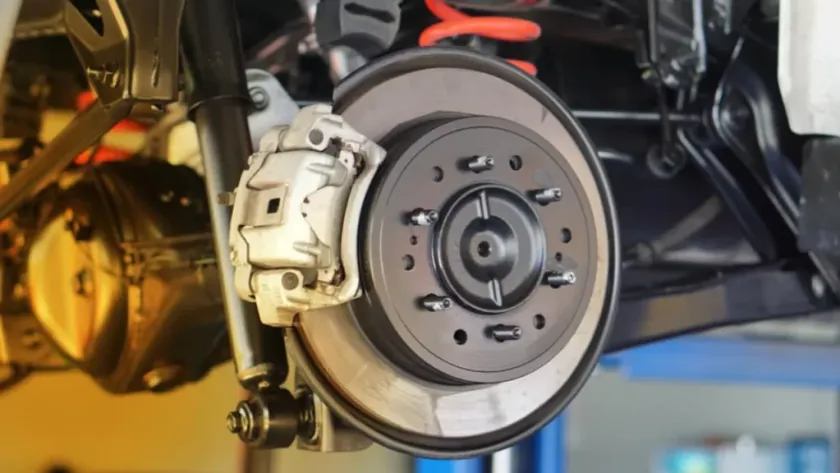Understanding ABS and EBD Braking Systems for Confident Driving on All Roads

(Photo credit: MendMotor)
In the modern world of driving, vehicle safety technologies have advanced significantly.
Two of the most crucial systems you should be familiar with are the Anti-lock Braking System (ABS) and the Electronic Brakeforce Distribution (EBD) system. These systems work together to help you maintain better control of your vehicle, especially in emergency situations on challenging road conditions.
What is ABS (Anti-lock Braking System)?
Imagine a situation where you have to brake suddenly on a slippery road. Without ABS, your car's wheels might lock up (stop rotating), causing the car to lose control and slide forward without the ability to steer.
ABS is a system that prevents the wheels from locking up during braking. It works by rapidly and intermittently modulating the brake pressure sent to each individual wheel to prevent any one wheel from stopping instantly and skidding along the road surface. This allows the tires to maintain grip on the road, and the driver can steer the car (maneuver around obstacles) even during severe braking.
How it Works:
- ABS has sensors that detect the rotational speed of each wheel.
- When it detects that a wheel is about to lock up (its rotational speed decreases abnormally fast).
- The system temporarily reduces brake pressure to that wheel, allowing it to rotate again.
- Then, it reapplies the brake pressure, repeating this cycle very rapidly (a pulsing action you might feel as a vibration in the brake pedal when ABS is active).
Benefits:
- Steering Control: Prevents the car from skidding out of control, allowing you to steer around obstacles.
- Shorter Stopping Distances (on some road conditions): Especially on slippery surfaces like wet roads or gravel, it can lead to shorter stopping distances compared to braking with locked wheels.
- Increased Safety: Reduces the risk of accidents caused by loss of control during emergency braking.
What is EBD (Electronic Brakeforce Distribution)?
While ABS focuses on preventing wheel lock-up, EBD enhances braking efficiency by distributing the braking force to each wheel optimally and proportionally based on the weight pressing down on that wheel during braking.
Why is Brake Force Distribution Necessary? When you brake, weight transfers to the front of the car, causing more weight to press down on the front wheels than the rear wheels. If the braking force were equal on all wheels, the rear wheels might lock up more easily than the front wheels, especially when the car has uneven weight distribution (e.g., passengers in the back or cargo in the trunk). This can lead to loss of stability or fishtailing.
How it Works:
- EBD works in conjunction with ABS, using the same sensors.
- The system calculates and adjusts the brake pressure sent to each wheel in real-time.
- For example, if significant weight transfer to the front occurs, EBD will increase braking force to the front wheels and reduce it at the rear wheels to prevent the rear wheels from locking and maintain vehicle stability.
- If there are passengers or cargo in the back, EBD will appropriately increase braking force to the rear wheels.
Benefits:
- Maximum Braking Efficiency: Utilizes the tire's grip to its full potential under all load conditions.
- Maintains Vehicle Stability: Prevents fishtailing or spinning due to rear wheel lock-up.
- Enhances ABS Performance: Makes ABS's anti-lock capabilities even more effective.
How Do ABS and EBD Work Together?
These two systems are like an inseparable pair. EBD first adjusts and distributes the braking force optimally to each wheel to ensure all wheels have maximum stopping power. Then, ABS takes over if any wheel is about to lock up by rapidly releasing and applying the brakes, allowing the driver to maintain steering control.
Simply put, EBD helps ensure the initial braking is as balanced as possible, while ABS acts as a "watchdog" to prevent wheel lock-up, so you can still steer.
What You Should Know When ABS and EBD Activate
- Pulsating Brake Pedal
It's normal! When ABS activates, you'll feel a pulsating sensation in the brake pedal, and there might be a grinding noise. This is a sign that the system is working at full capacity. Don't panic, and do not lift your foot off the brake pedal. Press the brake firmly and maintain constant pressure.
- Warning Lights
If the ABS or EBD warning light illuminates on your dashboard, it indicates a potential problem with the system. You should take your car to a service center for inspection immediately.
Understanding how ABS and EBD work will help you feel more confident and react correctly in emergency situations, which is crucial for safe driving on all road conditions.
Claim your free car valuation today!
Read More: Why Is the ABS Braking System Important During the Rainy Season?
Looking for a car appraisal? You can contact us for a free car valuation within 24 hours…
